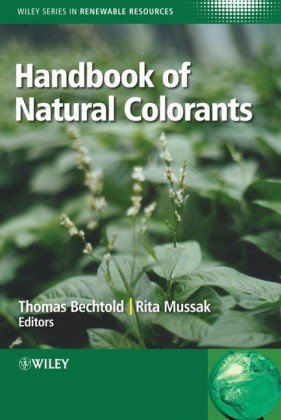Thomas Bechtold, Rita Mussak0470511990, 9780470511992
Written by scientists with specialised knowledge in the field, Handbook of Natural Colorants provides a unique source of information, summarising the present knowledge of natural colorants in depth. Supporting researchers in this emerging field of sustainable chemistry, it provides easy access to the theory and practice of natural colorants from different viewpoints, including agricultural, economic and legislative aspects.
Topics covered include:
History of coloration technology Present position of natural colorants Regional plant source availability Specific application techniques Chemical properties that professional dyers and chemists have to consider Agricultural sourcing of dyes with an emphasis on renewable resources Discussions on energy and material balance issues arising from the sourcing of materials Production aspects of colorants, leading on to the key applications Environmental and economic aspects
Also included are the pros and cons of natural dyestuffs, presenting some promising results and evaluating the potential use of vegetable dyes as alternatives to chemical-based ones with a focus on green chemistry
Table of contents :
Cover……Page 1
Frontmatter……Page 2
Color Plates……Page 23
Ancient Mediterranean World……Page 32
Dyes from Antiquity……Page 33
Unveiling the Secrets of Ancient Dyes with Modern Science……Page 34
Anthraquinone Reds……Page 35
Flavylium/Anthocyanin Reds……Page 37
Indigo Blues……Page 39
Anthocyanin Blues……Page 41
Ancient Purple (Tyrian Purple)……Page 42
Flavonoid Yellows……Page 44
References……Page 46
Introduction……Page 50
The Triumph of Mauvein: Synthetic Fulfilment of the Antique Purplemania……Page 51
Blue: from Kingly Regional to Globally Democratic……Page 52
Red and Yellow: from Micro to Macro Scales……Page 53
What Future for Natural Colorants in the Dawning Era of Renewable Resources?……Page 54
References……Page 55
Introduction……Page 56
Dyeing Techniques……Page 57
Woad……Page 58
Yellow……Page 59
Dyeing in Coptic Textiles……Page 60
Dyes in Islamic Textiles……Page 62
Mordants……Page 63
References……Page 65
Conclusions, Discussion and Summary……Page 67
General Facts……Page 69
Blue Dyeing Plants……Page 70
Red Dyeing Plants……Page 71
Yellow Dyeing Plants……Page 72
Brown Dyeing Plants……Page 74
References……Page 79
Introduction……Page 81
Annatto……Page 83
Turmeric……Page 85
Marigold……Page 87
Cochineal and Carmine……Page 88
References……Page 90
Brow-tuber (Botanical Name Dioscorea cirrhosa Lour, Family Dioscoreaceae)……Page 93
Indigofera tinctoria L…….Page 96
Strobilanthes cusia (Baphicacanthus)……Page 97
Acknowledgements……Page 102
Introduction……Page 103
Agronomy……Page 104
Introduction……Page 119
Agronomy……Page 120
References……Page 130
Acknowledgements……Page 132
Traditional Process Using Crushed Leaf Material……Page 141
Steeping in Water……Page 144
References……Page 157
Examples of Commercial Products and Processing……Page 161
Equilibria in Solution……Page 163
Colour and Colour Stability……Page 166
Anthocyanins as Antioxidants……Page 167
Plant Sources, Content, Influencing Parameters……Page 168
Food Colorants……Page 170
Other Uses……Page 171
References……Page 173
Other Sources of Anthraquinoid Dyes……Page 177
Lawson (2-hydroxy-1,4-naphthoquinone, CI Natural Orange 6)……Page 179
Juglone (5-hydroxy-1,4-naphthoquinone, CI Natural Brown 7)……Page 182
Main Components Emodin and Chrysophanol – Rheum Species and Rumex Species……Page 183
Main Components Alizarin and/or Pseudopurpurin/Purpurin……Page 185
References……Page 197
Use of Lichen and Mushroom Dyes in the Past……Page 209
Cultivation of Lichens and Mushrooms……Page 210
Lichen Dyestuffs: Orchils and Litmus……Page 211
Yellowish, Brownish and Reddish Colorants from Lichen……Page 217
Anthraquinones……Page 218
Other Colorants of Fungi……Page 222
Colour-fastness of Lichen and Mushroom Dyes……Page 223
References……Page 224
Use, Toxicology and Safety Aspects of Tannins……Page 227
Extraction and purification……Page 235
Quantification of Tannins……Page 236
References……Page 240
Problems in Carotenoid Analysis……Page 246
Chemical Characteristics of Natural Carotenoids……Page 247
Carotenoids Role as Pro-vitamin A……Page 250
Carotenoids in the Macular Region of the Retina……Page 252
Sampling……Page 253
Chromatographic Separation……Page 255
Detection and Identification of Carotenoids……Page 256
Quantification of Carotenoids……Page 258
References……Page 259
Stage of Maturity……Page 262
Climatic or Geographic Effects……Page 263
Changes in Processing/Cooking……Page 264
References……Page 266
Toxicological and Safety Aspects……Page 268
References……Page 278
Regulations on the Use of Flavonoid Colorants……Page 281
Structure……Page 285
Structural Transformation and pH……Page 287
Oxygen and Ascorbic Acid……Page 288
Enzymes and Sugars……Page 289
Sulfur Dioxide……Page 290
Co-pigmentation and Metal Complexation……Page 291
Yellow Flavonoid Pigments……Page 292
Tannins……Page 293
References……Page 296
Outlook……Page 300
General Basics……Page 301
Color Measurement……Page 305
Color Stability……Page 306
Dyeing for Analytical Purposes……Page 308
Impregnation……Page 309
Drying……Page 314
Steaming……Page 318
Thermal Treatment……Page 320
Ammoniation……Page 321
Bleaching……Page 324
Enzymatic Treatment……Page 326
Radiation……Page 328
References……Page 331
Acknowledgment……Page 337
Energy……Page 340
Dyestuff and Chemicals (Mordants and Auxiliaries)……Page 341
Dye-ability of Substrates……Page 343
Standardization of the Dyestuff……Page 348
Ecological Aspects……Page 349
Aspects of Application……Page 350
Dyeing Technology……Page 351
Mordanting……Page 352
Mixtures of Plant Material……Page 353
Hank Dyeing of Woolen Yarn and Production of Woolen Caps……Page 354
Dyeing of Polyamide Tights in a Paddle Dyeing Machine……Page 355
References……Page 357
Regulations……Page 360
Naphthoquinone Dyes – Henna and Walnut……Page 363
Indigo……Page 364
Metal Complexes……Page 366
Metal Reaction Dyes……Page 367
References……Page 368
Conclusion……Page 373
Cultivation of Dye Plants……Page 374
Residual Materials and By-products……Page 375
Selection Process for a Sustainable Supply of Plant Material……Page 376
Processing to Dyestuff……Page 377
Energy Consumption……Page 378
Water Consumption……Page 379
Raw Material……Page 381
Extraction of Dyestuff……Page 382
Transport……Page 383
Dealing with Sustainability……Page 384
References……Page 385
Conclusion: Aspects Influencing Market Development for Natural Colorants……Page 387
Range of Available Colours……Page 390
Market Research for Naturally Dyed Products……Page 392
21.5.1 enspCost Categories……Page 395
21.5.2 enspAspects Influencing Production Costs……Page 396
Prices of Synthetic Dyes – How Much Are Textile Companies Prepared to Pay for Dyes?……Page 398
Acceptable Production Costs through a Mixed Portfolio (Agricultural Primary Production and Residues from Other Production Processes)……Page 399
References……Page 403
Index……Page 405

Reviews
There are no reviews yet.